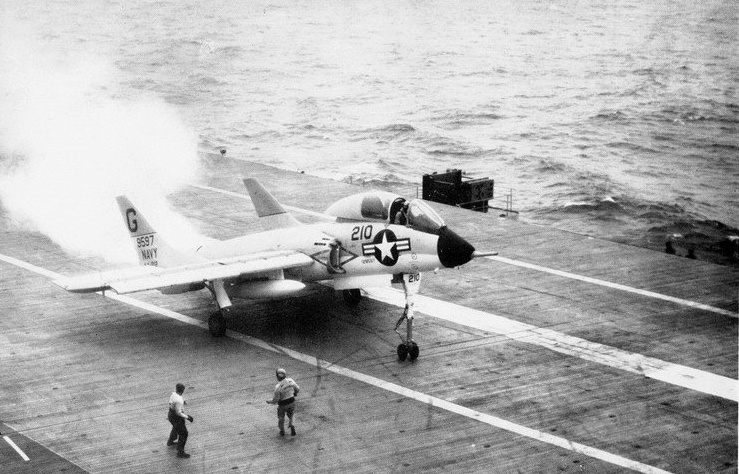‘I think the Bronze, Silver, and Gold for difficult aircraft to land has to go to Vought aircraft,’ David Tussey, former US Naval Aviator
Landing on the flight deck of an aircraft carrier is probably the most difficult thing a US Navy pilot will ever do. The flight deck only has about 500 feet (~150 meters) of runway space for landing planes, which isn’t nearly enough for the heavy, high-speed jets on U.S.ncarriers.
Each aircraft is equipped with a tailhook to land on the flight deck. The naval aviator‘s goal is to snag the tailhook on one of four arresting wires, sturdy cables woven from high-tensile steel wire.
There are four parallel arresting wires, spaced about 50 feet (15 meters) apart, to expand the target area for the pilot. Pilots are aiming for the third wire, as it’s the safest and most effective target.

But which US Navy jet is the most difficult or the easiest to land on the Aircraft Carrier?
‘I think the Bronze, Silver, and Gold for difficult aircraft to land has to go to Vought aircraft,’ David Tussey, former US Naval Aviator explains on Quora.
‘First up, the F7U Cutlass. It was just so poorly designed and had such terrible engines, that they were damn near impossible to land on a carrier. The accident and fatality rate was horrible. Look at the angle the airplane had to assume to land. Just a terrible (and frequently tragic) design. Earned the nickname The Ensign Killer.
‘In more modern times, the F-8 Crusader had a similar issue (also made by Vought). The angle of attack required to slow the aircraft for carrier approach speeds was so extreme that in order to prevent ramp strikes, the aircraft had to incorporate a movable wing to use during landings and takeoffs. (Actually, the fuselage moved, not the wing, but that’s semantics.) The Crusader is somewhat redeemed by having a reputation as a great fighter aircraft to fly. Still, very challenging to bring aboard the boat, and the subject of some horrific ramp strikes.’

‘And to complete the Vought triumvirate, a derivative of the Crusader, the A-7 Corsair, while better, was also very challenging to land on the carrier. (This was the aircraft that I flew for 800+ carrier landings.) The Corsair suffered from a slow response engine as well as a fast approach speed, so deviations during the approach were very difficult to manage. At least the wing didn’t move up and down.
‘Here’s me having a hard landing on a badly pitching deck onboard USS Midway. If you look closely, you can see the starboard wheel coming apart. Clearly, a controlled crash as were many A-7 Landings. Earned a trip to the bridge on this one.

‘The A-7 Corsair was, however, much loved by the Navy for its mission flexibility and effectiveness. So much of its terrible landing traits were forgiven.’
Tussey concludes:

‘I would propose that the easiest aircraft to land on the carrier, is the current F/A-18 Super Hornet. The Rhino not only has great aerodynamics, but also a super responsive engine, coupled with the amazing Maritime Augmented Guidance with Integrated Controls for Carrier Approach and Recovery Precision Enabling Technologies (MAGIC CARPET. The premise of this technology The premise of MAGIC CARPET is simple – rather than worry about adjusting roll, yaw, and pitch, adding and reducing power, and predicting how the plane’s course will intersect with the moving ship’s, the pilot can more directly and simply control flight path) greatly reduces pilot workload. (Finally!) Oh, the magic of digital flight controls. Just a superbly designed aircraft. Solid as a rock coming aboard.’
Photo Credit: David Tussey and Photographer’s Mate 3rd Class Christopher B. Long / U.S. Navy

